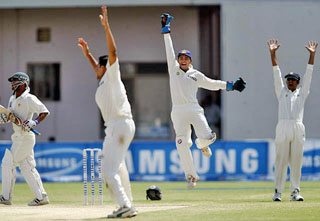ARTICLES
Simon Taufel stood out as the best
- By Piloo Reporter
Recently India created history by winning both the one-day and Test series in Pakistan. Wow! What a joy for the country. As per the ICC norms, it was one umpire from the ICC Elite panel and one from the host country for the One-Day Internationals and both umpires from the ICC Elite panel for the Test matches.
When the four umpires from the Elite panel were announced, I rated Simon Taufel from Australia to stand out as the best. Not just because he was only 33-years-young but I always felt that he was very sound and looked confident. Nine out of ten times he was correct. Yes, the occasional mistake does happen. But who doesn't commit mistakes? An umpire who commits lesser mistakes is supposed to be a good umpire. From all the matches played during the ODIs and Tests, it was found that majority of the wrong decisions given were suffered by India. It may be coincidental, but what can be the reason? Is it the pressure put by Pakistan or the vociferous crowd? What about the pitches? I would always like to see how these men stand in the sub-continent.
Apart from the one-dayers, the stadiums were comparatively far less populated. So, I would rate an umpire on how he handles the game (a Test match) at the Eden Gardens, Kolkata wherein more than 100,000 squeeze in. The mere roar as the bowler runs in is deafening. An appeal? It is not only the eleven players on the field but another 100,000 join them, especially if it is the home side. That would be the real test.
As we have all seen, there weren't many errors in the one-dayers in Pakistan. Even the home country umpires fared equally well. But the picture was quite different in the Test matches. Why? The answer is simple. ODIs are like one-way street. The object is to restrain the batting side and not necessary to get wickets. Similarly the batsmen try to score by hook or by crook. The close catching is only applicable for the first 15 overs and then the field stays scattered for most of the time. Whereas in a Test match it is different. There are number of close-in catchers. If a spinner is getting some assistance from the track, then the batsman remains surrounded as if by greedy vultures. This is the real test for an umpire. Limited overs games are thus easy than Test matches. Besides the third umpire is always there to help in case of run-outs which is the order of the day in one-dayers. But as it was seen with the help of the "Hawk Eye", there were numerous errors committed in giving leg Before Wicket (LBW) decisions. Practically in all the three Tests there were eyebrows raised whenever an appeal was rejected or answered affirmatively. Again a big question mark. While deciding on LBW, the umpires were extra cautions about the ball pitching slightly outside the leg stump. The next thought that flashes on their minds is "Did he get a nick or was the first impact on the bat or pad". Of course it is really easy to analyse after watching the slow motion replays. Now all this happens when the bowler hurls down at 90-odd miles an hour. To top it all the umpire has to watch the front foot on landing wherein some part of that foot has to be behind the inner edge of the popping crease, either grounded or raised. The track also plays an important part in the minds of the umps. An appeal for LBW on Australian wickets (decision as not out) can be given on sub-continental ones. In England the lateral movements of the ball remains the focus. So also in New Zealand to some extent.
The catches taken behind were also disputed in the series. But mainly these were collected down the leg side. Some had brushed the thigh pad (Youhana) at Multan and the impression in the umps mind was that it grazed the gloves. If there is a definite nick, I mean off the wood, than it is not so difficult. Similarly the bat/pad catches taken close by are easier to detect than glove/pad ones. The worst is first hitting the pad and then kissing the glove or the inner edge of the bat on the way to the fielder.
Only experienced umpires or seasoned ones can come out clean most of the time. S. Venkataraghavan of India, Peter Willey of England and Ashoka D'Silva of Sri Lanka have played the game at the highest level. But even they on occasions were found wanting. So the players know all this, I feel they should be able to take things in their stride and get on with the game. After all this game is a great equaliser!

Apart from the one-dayers, the stadiums were comparatively far less populated. So, I would rate an umpire on how he handles the game (a Test match) at the Eden Gardens, Kolkata wherein more than 100,000 squeeze in. The mere roar as the bowler runs in is deafening. An appeal? It is not only the eleven players on the field but another 100,000 join them, especially if it is the home side. That would be the real test.

Only experienced umpires or seasoned ones can come out clean most of the time. S. Venkataraghavan of India, Peter Willey of England and Ashoka D'Silva of Sri Lanka have played the game at the highest level. But even they on occasions were found wanting. So the players know all this, I feel they should be able to take things in their stride and get on with the game. After all this game is a great equaliser!